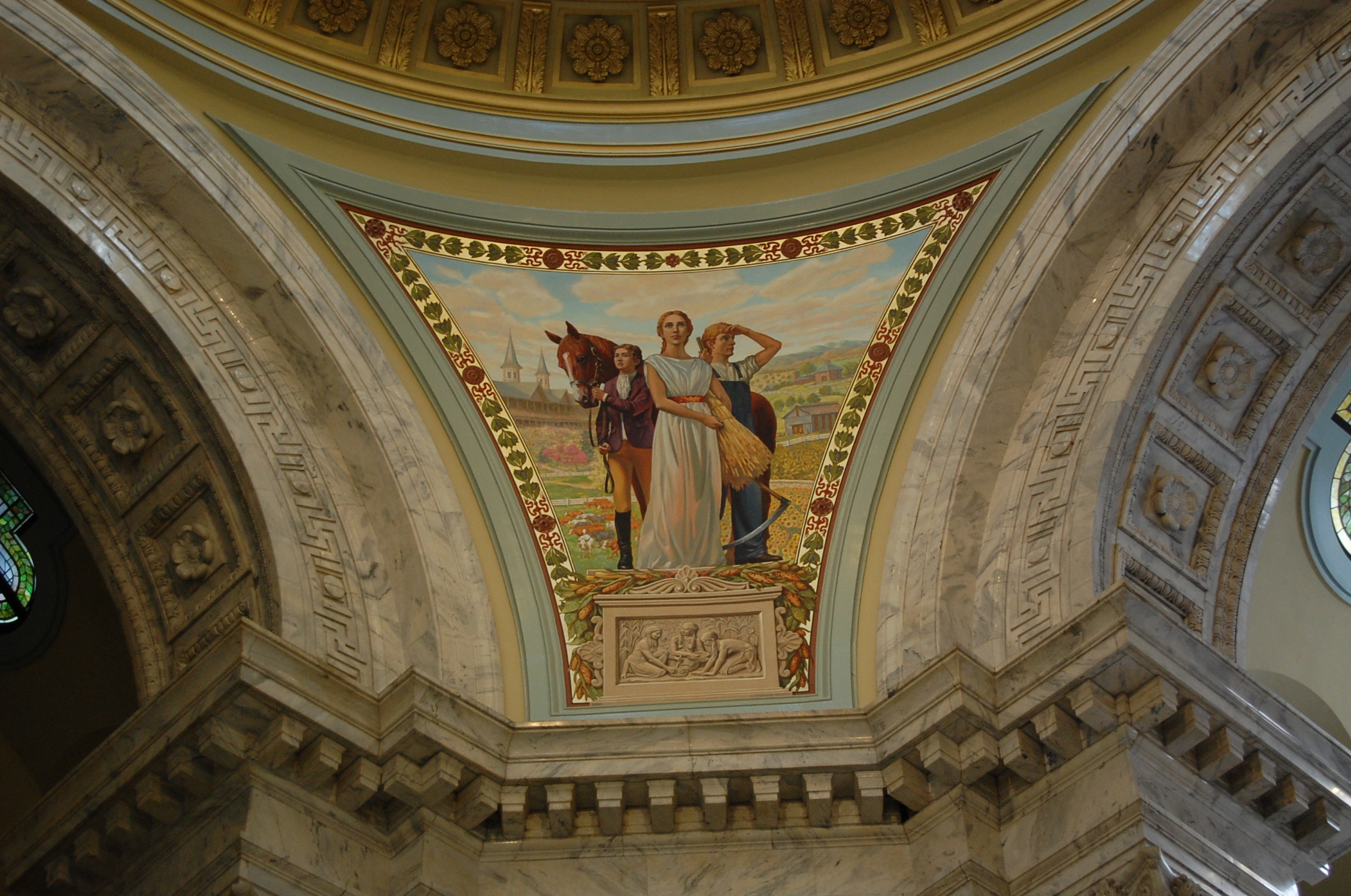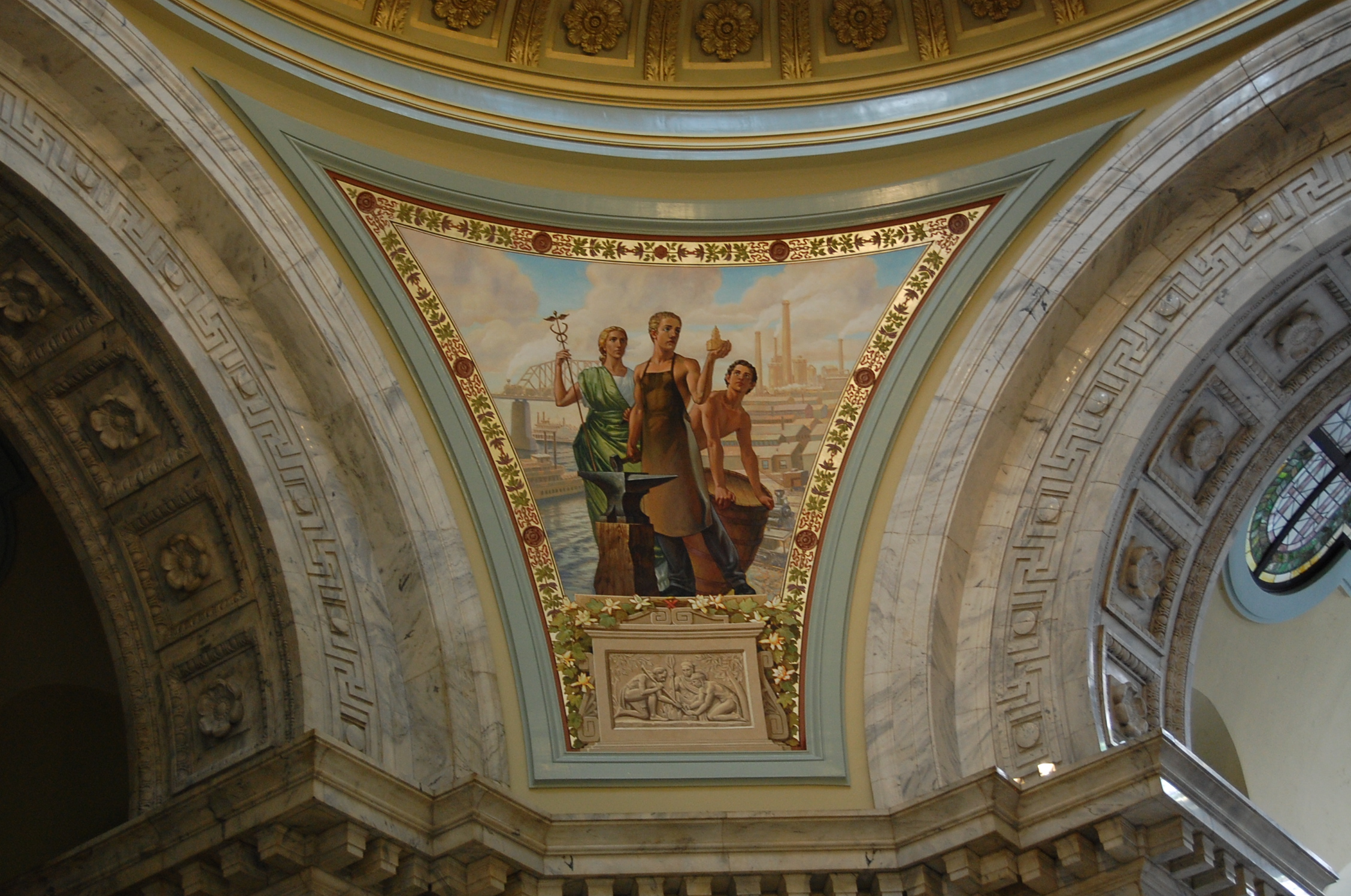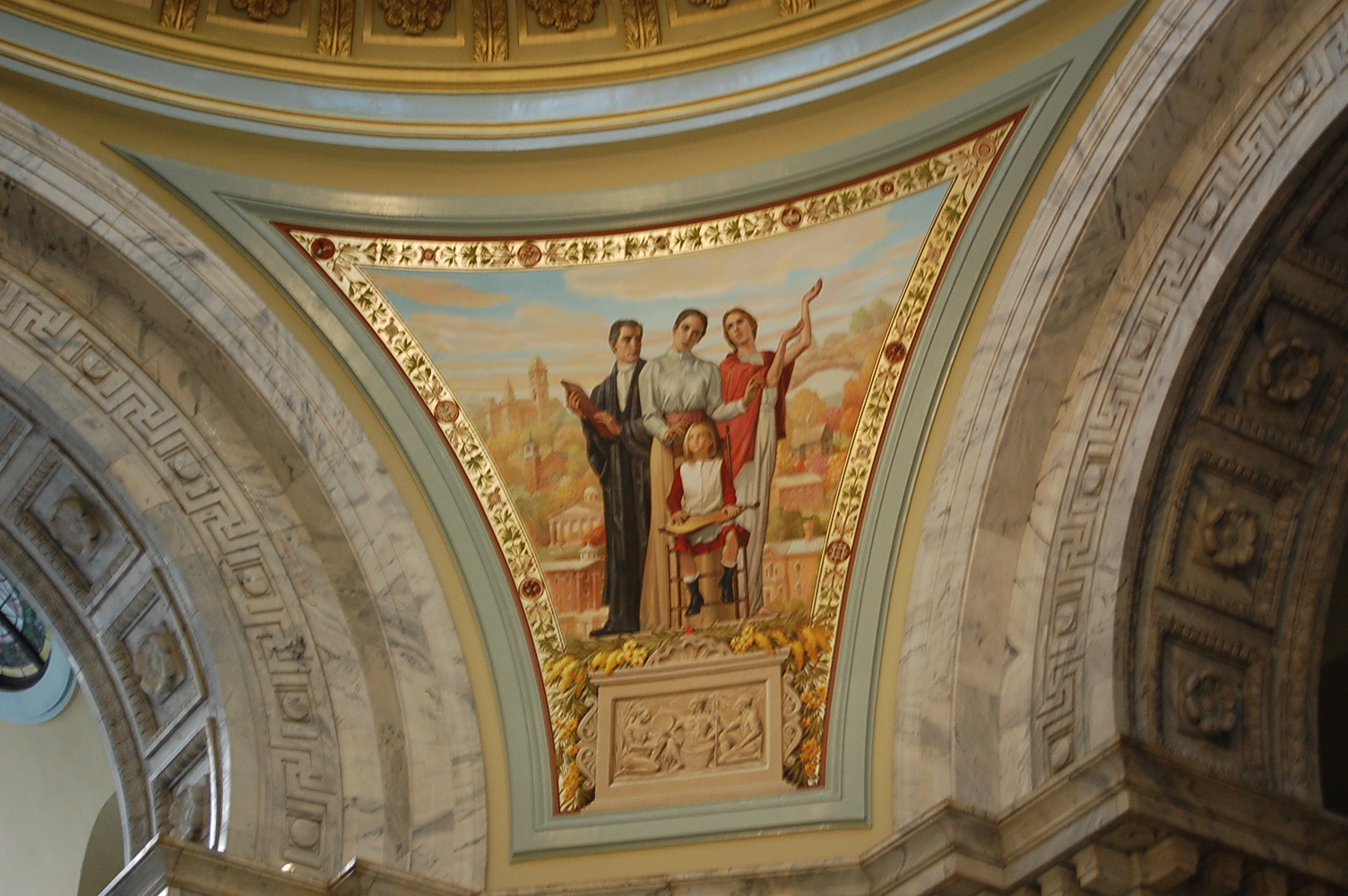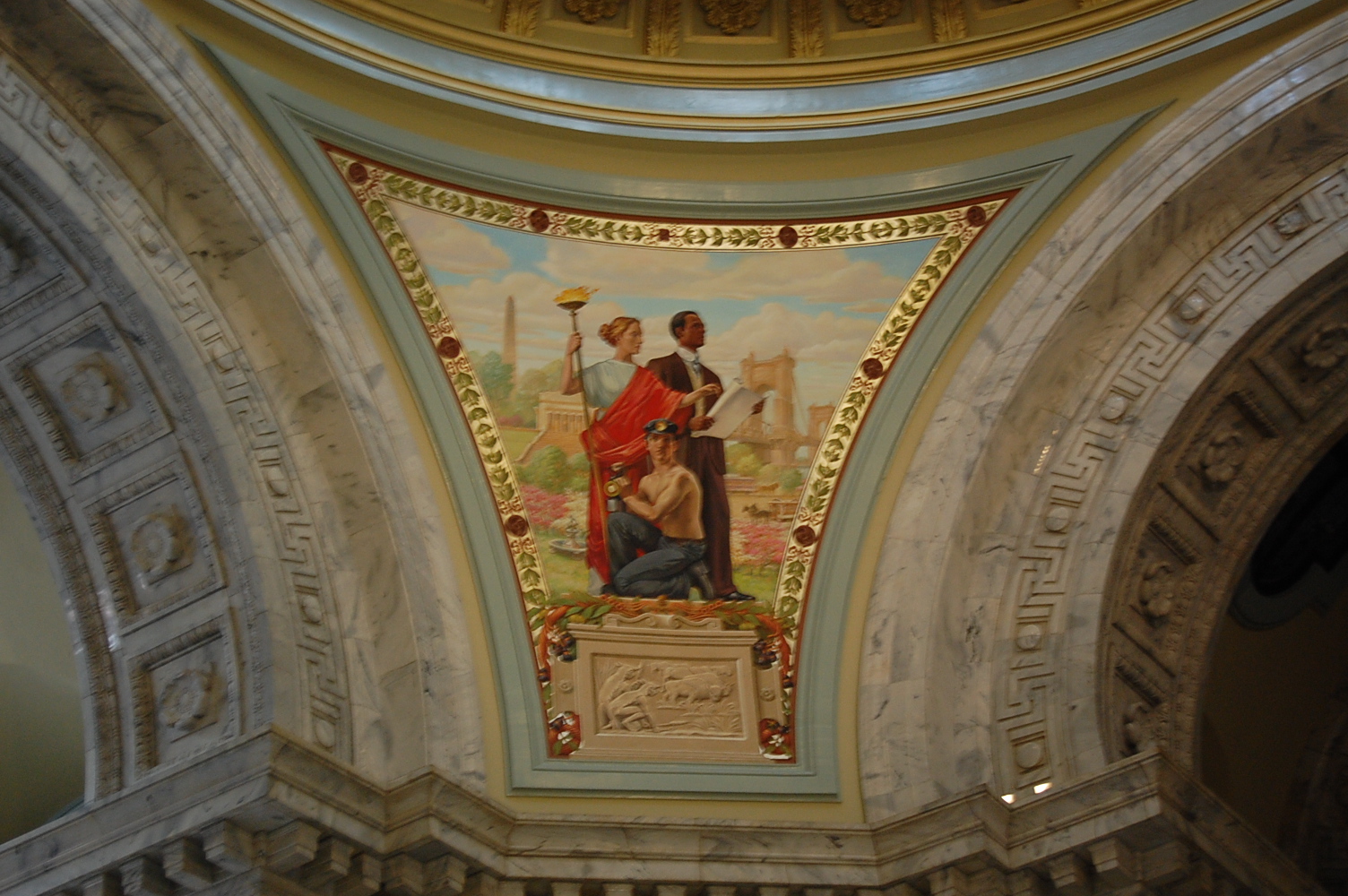Capitol Centennial Commission
Legacy Project
In 2009, a coveted project to complete the dome pendentives of the Kentucky State Capitol was realized. The original design for the State Capitol included spaces for murals within the pendentives, or the reverse triangular spaces directly beneath the dome, that were never completed until now. Marion and Terry Forcht of Corbin, Kentucky donated the funds to complete the murals and their installation. The generous gift is the largest in the history of the Capitol and is the Capitol Centennial Commission’s legacy project. Each pendentive combines modern and classical styles, in an effort to present a timeless, dynamic aesthetic. The murals unite elements of allegory, symbolism, and recognizable narrative. The four pendentive murals reflect the range of diversity, professions, landmarks, architecture and culture that comprises the rich social fabric of Kentucky’s past and present, as well as the unique landscapes of Commonwealth’s distinctive regions. Each pendentive features a background landscape highlighting different aspects and seasons of Kentucky’s natural beauty. Each group of figures stands on a trompe l’oeil bas relief vignette of Kentucky’s Native American Heritage, which serves as a literal and figurative foundation for the depiction of the modern commonwealth. The pendentive murals are trimmed by a shimmering gilded border, each of which is adorned with different iconic symbols to represent Kentucky. The murals were officially unveiled at the June 4 2010 Centennial Gala.

Nature
The Bounty of the Land
Ceres, the classical allegorical figure of agriculture and prosperity, symbolizes the bounty of Kentucky’s agrarian foundations. The pre- western beginnings of the Commonwealth are represented by a bas relief of three Native American women preparing corn. The border of the pendentive contains a motif of Indian corn, tobacco leaves, hemp rope and sunflowers. The sacred allegorical female is centered, vision focused towards the future. On her right a young female jockey holds the bridle of a shimmering beloved thoroughbred. Kentucky’s most recognizable landmark of our signature industry is supported by furrowed fields in the foreground, which contain horses, cattle, golden tobacco, limestone fences, hemp, sunflowers, etc. The farmer represented on the right is holding a scythe which is a symbol of the transformative nourishment of nature and the reaping of nature’s gifts. The rural landscape scene is punctuated on the right by the rising summer tapestry of the mountains of Eastern Kentucky. The farmer shields his eyes from the luminous glow of the early morning august sky indicating a bountiful harvest on the horizon.

Industry
The Power of Commerce
Mercury (or Hermes), the left hand female figure, is representative of the allegorical god/ goddess of commerce and trade. She holds a winged caduceus and tablet of knowledge. The Tulip Poplar blossoms and leaves serve as ornament and adornment for the bas relief of the Native American scene of the prehistory of industry. The trio is shown using fire, as visual precursors to people using fire for a forge. Kentucky’s river and steam paddlewheel heritage is celebrated behind Mercury. The figure on the right is manipulating a barrel of bourbon another signature industry of the Commonwealth. Bourbon distillery warehouses and other vestiges of turn of century industry such as locomotives and cranes are visible on the right side of the mural. The central figure can be thought of as Vulcan or a blacksmith and with his anvil and hammer solidifies the Commonwealth’s well documented history of manual labor, craftsmanship and industry. His strong left hand serves as a sturdy pedestal for the architectural accomplishment of our New Capitol building. The border of the Industry mural features wheels and gears which turn our industry intertwined with chains linking branches of the Kentucky Coffeetree our first state tree. A steaming locomotive crossing the Ohio River Bridge in Louisville on the left and the Ashland refineries lining the riverbanks of Northern Kentucky on the upper right provide ominous output to the hazy clouds of the cold January afternoon sky.

Culture
The Fruits of Knowledge
The woman figure on the right or Muse of the Arts represents the allegorical figure of music and dance traditions. A border of goldenrod, mountain laurel, prehistoric Native American rock art symbols, buffalo hide shields and wild flowers surround the scene. The bas relief highlights Native American men from the Woodland Period at Wickliffe Mounds in Western Kentucky depicted in a water drum ritual. The center female figure in traditional attire provides genteel instruction to an attentive young girl sitting in a ladder back chair handcrafted in Kentucky. The girl is learning from the teacher how to play the dulcimer, our state instrument. A robed male figure on the left holding leather-bound tome serves as the jurist or the moral and religious elements of faith, law and instruction. The natural bridge of the Red River Gorge, a part of the largest park system in the United States, provides a visual portal to the fruits of knowledge and culture. Historic landmarks and architectural styles from around the Commonwealth are featured in the mural. The architecture is in perfect harmony with the trees and sky bearing hues of orange, yellow and brown depicting one of Kentucky’s beautiful October autumn early evenings.

Civitas
The Light of Progress
Athena, the female figure, represents the goddess of civilization, progress and strength. Her torch and its flame symbolize knowledge, truth, enlightenment and hope. The bas relief portrays Native American men in animal skins hunting buffalo along Kentucky’s Buffalo Trace. The kneeling male and his glowing lantern illustrate illuminating the darkness to the Commonwealth’s cities through coal mining. The coal miner’s posture is sturdy and strong; he is a symbol of one of our signature industries. The African-American male to the right represents progress towards the future with enlightenment. The border of the mural scene is encircled by dynamo wheels and rotors of progress, electric wires and insulators to symbolize civil services and hickory tree branches represent our beautiful forests. The mural also highlights important advancements in transportation such as the mule drawn and electric streetcars and the Roebling Suspension Bridge. The Lincoln and Davis memorials represent the unique history and legacy of Kentucky’s involvement in the Civil War. The pendentive is punctuated by the blooming dogwoods and the palette of a mid-April springtime afternoon in Kentucky.